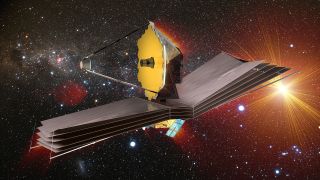Context
-
Recently, NASA’s James Webb Space Telescope (JWST), the largest and most powerful space telescope ever built, launched from French Guiana, on the northeast coast of South America, on the European Ariane 5 rocket.
-
It is the same space facility and the same rocket that the Indian Space Research Organisation uses to launch its heavier satellites.
About James Webb Space Telescope (JWST)
- The James Webb Space Telescope (JWST) is a space telescope developed by NASA with contributions from the European Space Agency (ESA), and the Canadian Space Agency (CSA).
- It is intended to succeed the Hubble Space Telescope as NASA’s flagship mission in astrophysics.
- JWST is an engineering marvel comparable to the earth-based Event Horizon Telescope that produced the photograph of the black hole, or the LIGO that detected the gravitational waves.

Credit: Space.com - It is widely expected to unveil many secrets of the universe, particularly those related to the formation of stars and galaxies in the early period — the first few hundred million years — after the Big Bang.
- Powerful space telescopes, like JWST or the Hubble Telescope, are often called time-machines because of their ability to view very faraway objects.
- JWST is much more powerful and has the ability to look in the infrared spectrum, which will allow it to peer through much deeper into the universe, and see through obstructions such as gas clouds.
- As electromagnetic waves travel for long distances, they lose energy, resulting in an increase in their wavelength.
- An ultraviolet wave, for example, can slowly move into the visible light spectrum and the infrared spectrum, and further weaken to microwaves or radio waves, as it loses energy.
- Hubble was designed to look mainly into the ultraviolet and visible regions of the electromagnetic spectrum.
- JWST is primarily an infrared telescope, the first of its kind.
-
JWST will also be positioned much deeper into the space, about a million miles from Earth, at a spot known as L2.
- It is one of the five points, known as Lagrange’s points, in any revolving two-body system like Earth and Sun, where the gravitational forces of the two large bodies cancel each other out.
- Objects placed at these positions are relatively stable and require minimal external energy to keep themselves there.
- L2 is a position directly behind Earth in the line joining the Sun and the Earth. It would be shielded from the Sun by the Earth as it goes around the Sun, in sync with the Earth.
Visit Abhiyan PEDIA (One of the Most Followed / Recommended) for UPSC Revisions: Click Here
IAS Abhiyan is now on Telegram: Click on the Below link to Join our Channels to stay Updated
IAS Abhiyan Official: Click Here to Join
For UPSC Mains Value Edition (Facts, Quotes, Best Practices, Case Studies): Click Here to Join
